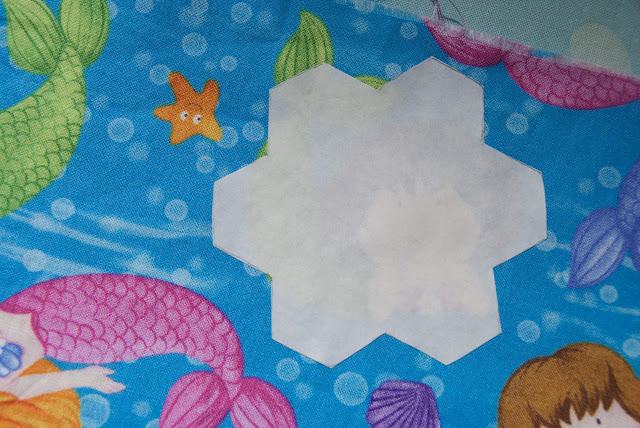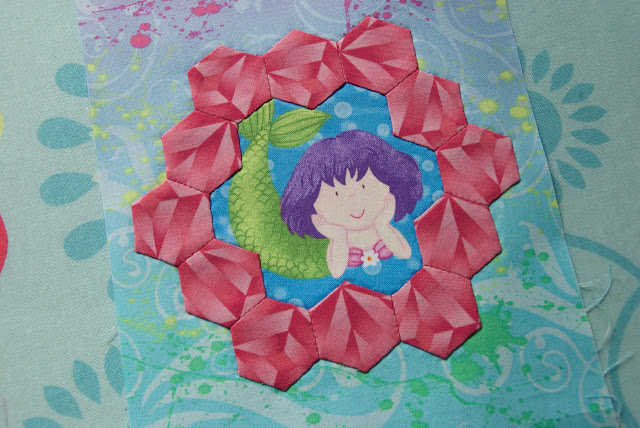I mentioned before that, finishing the bubbles quilt (which I eventually named "Color of Lightness, Color of Joy"), I realized that I had used freezer paper in three different ways in the process of making it. That's a good illustration of its versatility and usefulness for the quilt-building industry! And that's by no means an exhaustive list, I personally use it in two different ways for hand appliqué and for curved piecing as well (but that's a different story). As I didn't plan to write about it when I started I don't have all of the process photos, but I made a mock-up to fill in the gaps))
1. Freezer Paper for English Paper Piecing
For some it may be evident, for some maybe an eye-opener, but I find freezer paper EPP templates to be more convenient than ordinary paper which has to be pinned to fabric to hold it in place. What I do is print out a page of Geta Grama's hexagon templates, layer it over three pieces of freezer paper cut to A4 size, lightly iron them to each other so they stick together, and cut through all the layers to get a whole bunch of templates at once (follow the link above for Geta's detailed and clear instructions, and the templates also work for the "jewel" shape). Then I iron the freezer paper templates to the fabric, eyeballing the 1/4'' around them, and cut the fabric pieces out.
The resulting parts can be put into a box or bag waiting to be tucked - no pins needed! That said, if I'm making a lot of hexies, I usually use the printed paper templates as well, with pins.
2. Freezer Paper for Pattern Making
After I put together the hexagons for my bubble quilt, I had to prepare the background pieces. I was using two fabrics - the bubbles, of which I only had half a meter and the solid white, which was also limited, so I had to lay out the pattern pieces carefully to make sure I had enough fabric for the quilt. Moreover, the shapes of the "holes" inside the circles and the "edges" around them were all different and quite complex. So what I did was trace the hexagon shape onto freezer paper (dull side), cut out the pattern pieces and then play around with them, arranging them so that to make the best use of fabric (not forgetting a generous seam allowance).
Here is a little mock-up of the technique: a circle of hexies which I want to be filled with one fabric and surrounded with another.
The shape of the "hole" is traced onto the FP to make a pattern piece
The shape of the "hole" is traced onto the FP to make a pattern piece
FP is slightly transparent, so it even allows for fussy-cutting, although if you have to be precise, you'd better use plastic templates (I use plastic folders or pockets you can get in any stationary shop).
Now, the hexies can be appliquéd to the inside fabric. I used hand-applique in my quilt, but if we are to make something that will get a lot of handling, machine topstitching is preferable.
You can see that the generous seam allowance came handy, as I decided to reposition the motif a bit. Finally, the assembled piece can be appliquéd to the background. I decided not to make a hole in the background in this case, but in my quilt the background was all made up of separate pieces, cut to the corresponding FP patterns.
You can see that the generous seam allowance came handy, as I decided to reposition the motif a bit. Finally, the assembled piece can be appliquéd to the background. I decided not to make a hole in the background in this case, but in my quilt the background was all made up of separate pieces, cut to the corresponding FP patterns.
3. Freezer Paper for Quilting Templates
The complex shape of the "bubbles" didn't lend itself to any regular quilting, and the idea of bubbles itself called for irregularity, so I decided to do my hand quilting in random circles. I cut several circles of different sizes out of freezer paper and ironed them to the basted quilt sandwich, so that some of them touched.
I then quilted around the circles, the touching shapes made it possible to continue stitching the next circle without cutting the thread. I didn't use the quilting hoop, but I think these kind of templates could be used with a hoop as well.
After I quilted around all of my circles (I had seven of them, I think), I peeled them off and then ironed them to new places, so that they intersected with the previous ones. And so on and on and on - starting from the middle and out in two directions until everything was more or less uniformly quilted.
I then quilted around the circles, the touching shapes made it possible to continue stitching the next circle without cutting the thread. I didn't use the quilting hoop, but I think these kind of templates could be used with a hoop as well.
After I quilted around all of my circles (I had seven of them, I think), I peeled them off and then ironed them to new places, so that they intersected with the previous ones. And so on and on and on - starting from the middle and out in two directions until everything was more or less uniformly quilted.
So, I really find freezer paper an indispensable quilting supply for EPP, patterns, quilting templates and appliqué and I have an inkling that I haven't discovered all of its possibilities yet. What are your favorite ways to use freezer paper?
Linking up to Fabric, Thread and Yarn @ France Nadeau
Off the Wall Friday at Creations by Nina-Marie
Fabric Frenzy Friday at Fort Worth Fabric Studio
Linking up to Fabric, Thread and Yarn @ France Nadeau
Off the Wall Friday at Creations by Nina-Marie
Fabric Frenzy Friday at Fort Worth Fabric Studio













Thank you so much for sharing. I am a freezer paper fanatic, although it is almost impossible to find in South Africa and I so love all your ideas and different uses.
ReplyDeleteWhat would we do without freezer paper? I was afraid that they would stop making it, but when I bought my last two boxes (always buy two) there were instructions on the box for appliqué. I guess they are on to us.
ReplyDeleteThanks for a great blogpost.
Excellent, tutorial on ways to use freezer. Amazing how many ways it can be used.
ReplyDeleteGreat tutorial, freezer paper is fabulous - so is the quilt.
ReplyDeleteGorgeous quilt !
ReplyDeleteThanks for your visit !
Anna
Smart thinking. Great quilt. Like the circle quilting for straight line shaped design.
ReplyDeleteGreat tutorial. Beautiful quilt!
ReplyDeleteI must admit that I've never used freezer paper. Which is why I found your article quite interesting, particularly for uses 2 and 3. These are techniques I will definitely keep in mind. They seem to have worked very well for making your gorgeous quilt.
ReplyDeleteThank you for participating to my Fabric, Thread and Yarn link party. I wish you a beautiful Sunday!
I have a roll I carried back from the States and not used. I love the idea of using it as a guide for handquilting - thanks for that!
ReplyDeleteI hadn't thought about it, but I've used freezer paper in those 3 ways as well! As you say, it can have a lot of applications to quilting. Such a great post! You should continue the theme and post other ways to use freezer paper when you can. It's so good for quilting and easy to use.
ReplyDeletewonderful quilt and thanks for sharing the "how you do it"
ReplyDeleteThank you, Maggie, hopefully it will be useful to somebody))
DeleteI already use it for EPP it seems so obvious but using it for fussy cutting sounds like a great idea. Have you used it for applique. Seems like using Fp in art quilts is also a popular method though I am yet to see it explained anywhere. Glad I stumbled on your blog
ReplyDeleteI'm delighted with your work, congratulations!!!
ReplyDelete